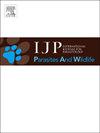A parasite through time: Revisiting Trypanosoma rajae Laveran and Mesnil, 1902 with new molecular and morphological insights from the blood of Rajidae in the western Mediterranean
IF 2
3区 医学
Q3 ECOLOGY
International Journal for Parasitology-Parasites and Wildlife
Pub Date : 2025-06-04
DOI:10.1016/j.ijppaw.2025.101097
引用次数: 0
Abstract
Trypanosomes are blood parasitic protozoa infecting Chordates, including the elasmobranch skates (Rajidae). Amongst, Trypanosoma rajae Laveran and Mesnil, 1902 is a century old parasite, first briefly described from the Mediterranean starry ray Raja asterias and the undulate ray R. undulata off Roscoff, France, Northeast Atlantic, for which illustrations and molecular data are still lacking. Herein, we investigate blood trypanosomes of R. asterias, type-host of T. rajae and of those from the blood of the brown ray R. miraletus, collected off the Algerian coast, Western Mediterranean. We describe these trypanosomes using an integrative taxonomic approach combining morphological characters and partial 18S rRNA gene sequencing, and we provide several morphological, morphometrical, anatomical and biological characteristics (division stages). Specific characteristics of Trypanosoma ex R. asterias such as granulations of the nucleus and cytoplasm; shape of the kinetoplast, nucleus and body; tip of the body; the undulating membrane, as well as the morphometric measurements were within the ranges given in the previous records of T. rajae, and we ascribe thus the newly collected trypanosomes from R. asterias to T. rajae. Algeria and the Western Mediterranean are new locality records for T. rajae. Trypanosomes ex R. miraletus differed from T. rajae ex R. asterias by some morphometrical data: posterior end to kinetoplast (PK), free flagellum length (FF), the kinetoplast index (KI), slenderness (Sle), flagellar index (FI), mid-nucleus to anterior end (NA) and parasite maximum body width at nucleus (BWN). Partial 18S rRNA gene sequences of T. rajae ex R. asterias and Trypanosoma sp. ex R. miraletus showed ∼99.76 % similarity. We take a conservative position and refer to trypanosomes from R. miraletus as T. cf. rajae. Phylogenetic analysis using 18S rRNA gene sequences of other aquatic trypanosomes allowed positioning of T. rajae relative to the other trypanosome species, previously described, infecting marine and freshwater hosts worldwide. Some divisional stages were also observed on MGG-stained thin smears allowing a brief description of the division of this trypanosome in the blood of its host. This effort is the first study of T. rajae using integrative taxonomy combining morphology and DNA and we provide for the first time observations of dividing stages of this species in the host blood.

穿越时空的寄生虫:从地中海西部Rajidae的血液中获得新的分子和形态学见解,重新审视rajae Laveran和Mesnil锥虫
锥虫是一种感染脊索动物的血液寄生原生动物,包括滑鳐(滑鳐科)。其中,锥虫rajae Laveran and Mesnil, 1902是一种有百年历史的寄生虫,最初在地中海的星空射线Raja asterias和法国东北大西洋Roscoff的波状射线R. undulata中被简要描述,目前仍缺乏插图和分子数据。在此,我们研究了在地中海西部阿尔及利亚海岸采集的拉贾伊弓形虫的类型宿主——asterias弓形虫和褐射线miraletus弓形虫的血锥虫。我们使用结合形态学特征和部分18S rRNA基因测序的综合分类方法来描述这些锥虫,并提供了几种形态学,形态计量学,解剖学和生物学特征(分裂阶段)。星形锥虫的特异性特征,如细胞核和细胞质的颗粒;着丝体、细胞核和体的形状;身体的尖端;波浪形膜和形态测量值均在前人记录的范围内,因此我们认为新采集到的大角锥虫属于大角锥虫。阿尔及利亚和西地中海是拉贾疟原虫新的地方记录。miraletus锥虫与rajae ex asterias锥虫在形态计量数据上存在差异:动质体后端到动质体(PK)、游离鞭毛长度(FF)、动质体指数(KI)、细细度(Sle)、鞭毛指数(FI)、中核到前端(NA)和寄生体最大核宽(BWN)。rajae的部分18S rRNA基因序列与miraletus的部分18S rRNA基因序列相似度为99.76%。我们采取保守的立场,将miraletus的锥虫称为T. cf. rajae。利用其他水生锥虫的18S rRNA基因序列进行系统发育分析,可以将拉贾锥虫相对于之前描述的其他锥虫物种进行定位,这些锥虫感染世界各地的海洋和淡水宿主。在mgg染色薄涂片上也观察到一些分裂阶段,可以简要描述该锥虫在其宿主血液中的分裂。本研究首次采用形态学和DNA相结合的综合分类学方法研究了棘球绦虫,并首次对棘球绦虫在宿主血液中的分裂阶段进行了观察。
本文章由计算机程序翻译,如有差异,请以英文原文为准。
求助全文
约1分钟内获得全文
求助全文
来源期刊

International Journal for Parasitology-Parasites and Wildlife
Medicine-Infectious Diseases
CiteScore
3.80
自引率
5.60%
发文量
113
审稿时长
45 days
期刊介绍:
The International Journal for Parasitology: Parasites and Wildlife (IJP-PAW) publishes the results of original research on parasites of all wildlife, invertebrate and vertebrate. This includes free-ranging, wild populations, as well as captive wildlife, semi-domesticated species (e.g. reindeer) and farmed populations of recently domesticated or wild-captured species (e.g. cultured fishes). Articles on all aspects of wildlife parasitology are welcomed including taxonomy, biodiversity and distribution, ecology and epidemiology, population biology and host-parasite relationships. The impact of parasites on the health and conservation of wildlife is seen as an important area covered by the journal especially the potential role of environmental factors, for example climate. Also important to the journal is ''one health'' and the nature of interactions between wildlife, people and domestic animals, including disease emergence and zoonoses.
 求助内容:
求助内容: 应助结果提醒方式:
应助结果提醒方式:


